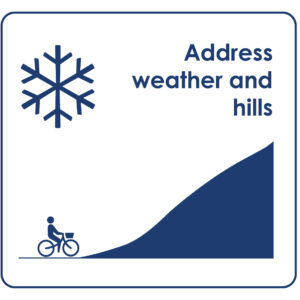 While cold, snowy weather and hills can make cycling challenging, some Canadian cities are successfully overcoming these obstacles. Metro Vancouver has a cycling mode share of over 2%, despite being very hilly. Greater Montreal and Ottawa-Gatineau are both at 2% or higher, despite each receiving an average of 54 days of snow a year and average January temperatures of -10°C. Winnipeg, despite being very cold, is almost entirely flat and has a mode share of nearly 2%. Halifax presents an opportunity, with cycling rates that are currently lower than Montreal, Ottawa and even Winnipeg, despite being considerably warmer and less snowy. Municipalities can address the challenges of hilliness and weather through a combination of infrastructure and programming to make cycling a more attractive option throughout the year for people of all fitness levels.
While cold, snowy weather and hills can make cycling challenging, some Canadian cities are successfully overcoming these obstacles. Metro Vancouver has a cycling mode share of over 2%, despite being very hilly. Greater Montreal and Ottawa-Gatineau are both at 2% or higher, despite each receiving an average of 54 days of snow a year and average January temperatures of -10°C. Winnipeg, despite being very cold, is almost entirely flat and has a mode share of nearly 2%. Halifax presents an opportunity, with cycling rates that are currently lower than Montreal, Ottawa and even Winnipeg, despite being considerably warmer and less snowy. Municipalities can address the challenges of hilliness and weather through a combination of infrastructure and programming to make cycling a more attractive option throughout the year for people of all fitness levels.
ACTIONS
- Target a grade of 3% or less for cycling infrastructure, and consider mitigation measures (short, steep sections followed by a flat or a wider path) when a steeper grade is necessary.
- Give cyclists a hand through an elevator, an uphill bus shuttle, or an e-bike share service.
- Provide sufficient space and protection so cyclists can travel slowly uphill without worrying about motor vehicle traffic.
- Designate a network of cycle tracks and bike lanes as year-round routes and maintain them throughout the winter. De-ice and clear these routes more frequently than roadways, as cyclists are more sensitive to ice and snow accumulation.
- Develop a marketing campaign to encourage and normalize winter cycling.
EXAMPLES

- Vancouver’s Transportation Design Guidelines for All Ages and Abilities Cycling Routes provides guidance on designing for hills.
- Hamilton’s Mountain Climber program allows cyclists to ride the bus for free up or down Hamilton’s steep escarpment.
Quebec’s free Ascenseur de Faubourg, is an elevator which connects the lower town neighbourhood of St Roch with the upper town St-Jean-Baptiste. Bicycles are welcome. - Montreal’s Four Season Bike Network was begun in 2014, with 260km of bike lanes maintained. In 2018-2019, the network encompassed 595km, or 76% of the city’s bike infrastructure.
- Calgary’s “Who bikes in the winter?” and Winter Bike Photo Booth campaigns collect and share stories and images of everyday Calgarians choosing to bike in the cold weather. Also, the City’s dockless bike share pilot project includes a fleet of electric pedal assist bicycles from Lime.






